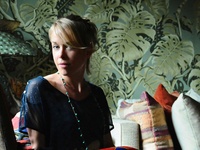Anna Laurent ’00 is a writer and photographer whose body of work combines her interests in visual art and botany. She is a recipient of the Royal Horticultural Society’s silver-gilt medal for her work at the Chelsea 2017 Flower Show and has also authored “Botanical Art from the Golden Age of Scientific Discovery,” a book that features large, detailed, and full-color botanical illustrations with captions that provide information on relevant botany and historical context. One of Laurent’s ongoing projects, “Dispersal,” is a series of photos that explores plant reproduction and the varied ways that plants both protect and disperse their seeds. The Harvard Crimson sat down with Laurent to discuss her current work and how her experiences as an undergraduate at Harvard have shaped her career.
The Harvard Crimson: What did you study while at Harvard?
Anna Laurent: I graduated with a degree in American History and Literature, but that was after a sort of tussle [during] freshman and sophomore year. My comfortable place in high school had always been literature, but I took a science core class freshman fall: Science B-29. I don’t remember the formal title of the course, but everyone called it “Sex,” because it was really about how all species and organisms have evolved behaviors and structures to reproduce … and I loved the idea of looking at behaviors and morphological, physical features of organisms with this common function that unifies all of us but manifests in very different ways.
So I declared a concentration in Biological Anthropology, and started fulfilling some of the requirements. I think my enthusiasm didn’t falter, but maybe my conviction did a bit, as I didn’t consider myself a scientist, and I was concerned that requirement would be more onerous. I also didn’t find any topic that I really wanted to focus that line of inquiry into… Finally, I remember it was this battle in my head of what concentration to declare, and I decided to do Hist and Lit.
THC: So when you were an undergraduate, did you know that you’d be pursuing something along the lines of nature and art?
Multimedia
AL: No idea. When I graduated, I worked for Let’s Go for a couple of years, and then I went to design school, then started working in documentary films. I liked working in an aesthetic medium, but I wanted to create content more than [I wanted to do] graphic design. I felt like it wasn’t intellectually satisfying. I drifted to documentary film, and now there’s this project: “Dispersal”.
THC: What inspired “Dispersal”?
AL: It really started with that core class freshman year. I don’t know if it would have happened if I hadn’t had that.
THC: How did you become interested in botany, and what was the reasoning behind the focus on seed pods for the “Dispersal” project?
{shortcode-1c4dfb2a8b6d38e8dbc96669432dd0a3fad7514d}AL: The diversity of structures that have evolved to fill these common functions, of keeping the seeds safe as they mature and then dispersing them in a way that makes sense in their environment. And that [seed pods] aren’t celebrated as much as flowers are… [and] to remind audiences that when a flower falls off, it’s not the end of the plant. It’s just the beginning. Seeds are just these little packages of DNA that need to get to the right place. Once a seed starts to germinate, that’s the only shot it has… And then just aesthetically, certainly, my background in design informed the project because I appreciated all these textures and patterns and colors that looked like sculptural abstractions.
THC: What is your creative process?
AL: I want to show the relationship between the seed and the other structures [of the plant] as much as possible. I want them showing a sense of movement, because there is movement in dispersal—they themselves are static, but there is movement. I don’t have a lot of rules, but I do know that my formula sort of creates these images that look sculptural or architectural.
THC: Do you have any ideas for future projects?
AL: So far, I’d collected in the wild, and I’d collected at botanical gardens, but not with any theme in mind. I would like to do something that has a more directed theme ... I’m also thinking about doing a project exploring the spore patterns on ferns, because, similar to seed pods, you don’t really seem to notice them. The sporangia have a variety of patterns, but they’re under the leaves, so they’re not often visible. You don’t think to turn the fronds over and see lots of different patterns.
THC: Do you have any advice for Harvard students who aspire to go into the arts?
AL: Don’t worry if you’re about to embark on a new discipline—it doesn’t need to be forever. Maybe you’re only going to work with it or study it for a few months, or a day, or a week … Everything we engage in, if we do it with our full hearts and heads, brings us to a different place. And in that new place, we’re able to perceive direction and inspiration.
If something feels right, do it and see where it goes.
—Staff writer Patricia M. Guzman can be reached at patricia.guzman@thecrimson.com.
Read more in Arts
Harvard Art Museums' Study Center Showcases Warhol CollectionRecommended Articles
-
Vartan Gregorian on HarvardVartan Gregorian, the President of the Carnegie Corporation of New York and an authority on higher education, recently spoke to
-
Encore! Encore!: Prof. Kelley's LatestAt Harvard, we are supposed to get a liberal education. For most of us, this means learning about the occasional
-
Porn Free: Talking To Andrea DworkinWhen Andrea Dworkin speaks, her voice quivers with the fervor of reckoning. “Women,” she says, a hand clutched to her
-
Pop Culture Flashback! Jem: Truly OutrageousWhen you’re young, it’s natural to fantasize about being someone else. As a teensy girl, I stared at Mary Lou
-
 Artist Spotlight: Andrew Lippa
Artist Spotlight: Andrew Lippa














